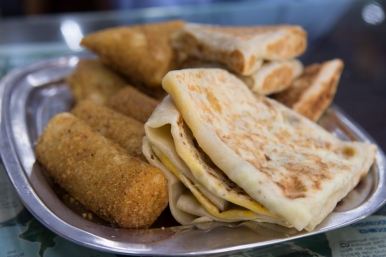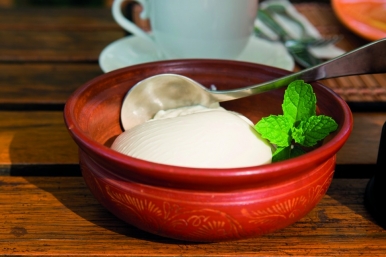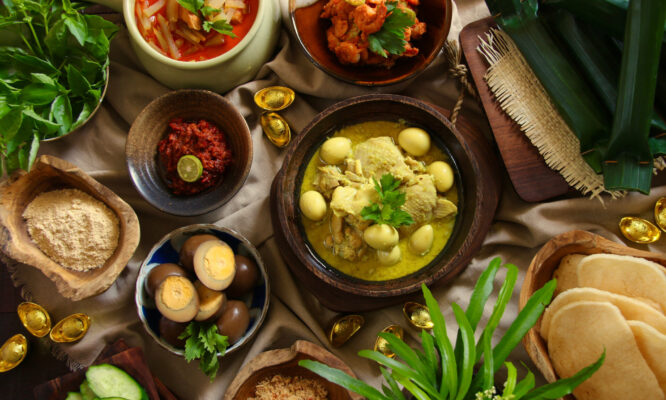Full of colour and flavour, Sri Lanka’s cuisine more than holds its own

Every Sri Lankan meal decorates the table with a rainbow of dishes; no rice is complete without curry, no curry without the accompanying sauces and salads. Brown rice, yellow dhal, green mallum, orange pol sambol and red lunu miris join the day’s spice-laced curry to make up the basics of a meal in this island nation.

Shaped like a droplet of water running off India’s southeast coast, Sri Lanka might be dwarfed in size and reputation by its neighbour, but when it comes to cooking, the big flavours, tongue-searing sauces, and vivid assortment of food that graces every table, it holds its own.
Though Sri Lankan cuisine holds some similarities to the food of its neighbour – particularly that of the southern Indian states of Tamil Nadu and Kerala – the island’s geography blessed it with its own homegrown favourites, tweaked by the influences of various occupiers and traders who stopped in at this crossroads of the Indian Ocean.

Curries serve as the centrepiece, coming in an endless combination of colours, proteins and styles: fiery red Jaffna curry from the Tamil north of the island, black pork curry from the hilly centre, and coastal fish curries. Unlike the thick, rich curries of Thailand, or the chunky curries of northern India, Sri Lankan curries tend to have a slightly thinner broth, with larger pieces of protein – meat or seafood – afloat in the fragrant, strongly spiced broths.
Fish curry, spiced red with heat or white with coconut milk, is common, as well as its relatives – shrimp, crab, or squid. Pork curries are often dark with tamarind to cut through the fat, or made with a similar local ingredient called goraka.

Because of the religious leanings of much of the island, beef is rare, but chicken curry, mostly made with thighs, is found everywhere. Vegetable curries – okra, spinach, and potato among the most common – show up at many feasts, but only as a side or secondary dish, while the meat or seafood is the centrepiece. Many, though not all, Sri Lankan curries pack a dose of fiery heat – without the heft of some of its relatives, the hit of spice is powerful, tamped down only by the meal’s starch.
Alongside the curry, each meal usually comes with rice or a rice-based starch, used to pick up the curry and accompaniments with one’s hand. The grain shows up in every shade – red, black, white, brown, or even multi-coloured – but which variety of rice is only the beginning of options. Rice flour forms bowl-shaped pancakes called hoppers – at their best with an egg cooked into the bottom – and their noodle-tangle relative, the string-hopper, as well as in the coconut and rice flour moulds known as pitthu – coconut being, perhaps, the only ingredient in Sri Lanka as prevalent as rice.

As any visitor quickly learns, the secret to survival in the muggy heat lies in the stacks of giant yellow coconuts for sale on the side of every road. Vendors use a machete to open a hole and stick a straw in, providing instant cool, hydrating relief. Once finished, the seller will take the coconut back and carve a spoon from the side to scrape the meat out. It’s the most basic of coconut uses, but only the beginning.
Almost every rice and curry comes with pol sambal, a shredded coconut garnish that often packs a bit of heat. Coconut folds into various types of greens for mallum, a stir-fried vegetable side often served with meals. And, of course, it finds its way into nearly every dessert – from the airy flan-like watallapan to lavaria, string hoppers stuffed with sweetened coconut.

Beyond curry, rice, and coconut, no Sri Lankan meal would be complete with two more elements: the sharp spice of lunu miris, and the calm, steady support of a good dhal. Lunu miris, a chopped sauce of chillies, onion, lime, and Maldive fish – a cured tuna used to add savoury support in Sri Lankan cooking – adds heat and crunch to the meal, but also rounds out a piece of roti for an afternoon snack. Dhal, the stewed lentil dish seen in endless varieties around the sub-continent, tends to be thin and yellow here, a stalwart of the Sri Lankan table.

Thick, hearty coconut roti can be a substitute for rice at a meal or a snack on its own, while the larger, thinner gothamba roti is often stuffed with meat or fish as a street snack – one of many options known as ‘short eats’. The same roti also gets flamboyantly chopped and griddled with eggs, meat, vegetables, and spices to become kotthu. The street-side spectacle of flecks of ingredients flying at high speed over the hot griddle is as impressive to watch as it is to eat – something like fried rice, with tiny pieces of the flatbread in place of the grain.
Despite its diminutive size, Sri Lanka holds thousands of treasures in its cuisine – those discussed here are but the essentials: the basic building blocks and most common dishes. We haven’t even begun to discuss the Dutch-influenced rice speciality called lampreis, go into the details of the fritters and Chinese rolls that make up ‘short eats’, or delve into the wonder that is buffalo curd – a creamy yogurt-like concoction made from water-buffalo milk, divine with palm treacle.

More important than knowing each dish is in knowing where to get it. While finding restaurants in big cities like Colombo and Kandy is easy, the best way to find good food in rural areas is to look for local guesthouses called ‘rests’ and ask if they’ll serve dinner later that night. Short eats, roti, and even hoppers are easier to find on the street – you’ll probably see them stacked in a display case or being cooked fresh as you pass by. Whatever you find, the key to Sri Lankan food is embracing its strong flavours and bright colours with a big appetite.









